Dubliner in British Military Intelligence
Published in Decade of Centenaries, Features, Issue 4 (July/August 2014), Volume 22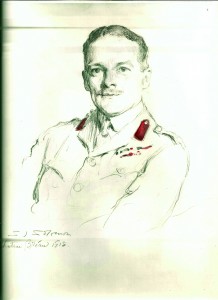
A 1918 sketch of Major J.A.F. Cuffe by Solomon J. Solomon.
By 1911 European governments were eyeing each other with suspicion but, for the time being, social and commercial life went on. This included an international exhibition in Ghent, Belgium. On his return from Germany earlier in the year, Dubliner Captain J.A.F. Cuffe of the Royal Marine Light Infantry, now fluent in German and French, was dispatched to Belgium on a Triumph motorbike. Officially, he was an extra attaché at the British Embassy on a motorcycle trip. Unofficially, his instructions were to spy and discover which route an invading army would be likely to take. From this time until the end of the war Cuffe remained in Belgium and France, spying on German positions and reporting back to Allied HQ. His reports dated 6 January 1916–25 May 1918 are extant. There must have been earlier ones because Cuffe was provided with a carte d’identité and letters of introduction, and the first of these is dated 25 May 1914.
Cuffe’s reports described the supply routes the Germans would need to use and which railway bridges should be blown up. The first extant document (6 January 1916) describes the recent increase of arms and ammunition available to the Germans. Cuffe had spoken to German prisoners and had learnt that schools had been established to train ‘cripples and women’ for ammunition work and that field guns were being built by a dozen different firms, as well as the state arsenals. Cuffe reported on the movement of troops and on 1 February 1916 he commented on an increase in the enemy’s fire in the Arras area. On 30 December he pointed out that the supplies for Ypres appeared to come through Ghent, so the obvious method of interfering with the supply line would be by cutting the bridges over the Scheldt, but these would almost certainly be very carefully guarded.
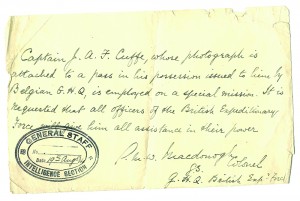
A note dated 19 August 1914 and signed by his cousin, Colonel (later General, Sir) G.M.W. Macdonogh, director of military intelligence, GHQ British Expeditionary Force, explaining that Captain J.A.F. Cuffe was employed on a special mission and requesting that officers of the British Expeditionary Force should give him every assistance in their power. There are many of these notes in both French and English.
German withdrawal to the Hindenburg Line
A report dated 31 December 1916 and headed ‘secret’ described the possibility of a German attack on Italy through Switzerland. German agents and pro-Germans had been much in evidence at the Vatican, but so far had failed to win over Pope Benedict XV or his secretary, and an attack on Italy via Switzerland would certainly antagonise neutrals. Railways and supply routes continued to be Cuffe’s main concern. On 15 January 1917 he referred to the Somme offensive. He pointed out that some of the information he received was based on rumours purposely started by the enemy. As he spoke both French and German, Cuffe gathered information not only from local people but also from prisoners. There are many mentions in his reports of the German withdrawal to the Hindenburg Line in the winter of 1916–17 and the fact that villages had been evacuated and houses destroyed by the enemy, thus limiting billeting accommodation available to the advancing Allied armies. A detachment of cyclist Jägers (an élite corps recruited from hunters and woodsmen) was brought in to carry out the demolitions, which were supposed to be carried out by hand but instead houses were set on fire.
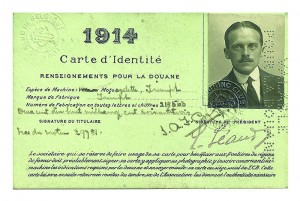
Captain James Cuffe’s 1914 Belgian carte d’identité. Officially, he was an extra attaché at the British Embassy on a motorcycle trip. Unofficially, his instructions were to spy and to discover which route an invading army would be likely to take.
On 21 March 1917 Cuffe noted that he had heard reports that von Mackensen, the German general with most fighting experience, had established his headquarters near Tournai. Cuffe was concerned that if there was a successful German offensive between Arras and the La Bassée Canal this would not only deny the Allied armies the use of the coal fields but would also seriously threaten the communications of Allied troops operating against the Hindenburg Line. On 1 April 1917 Cuffe noted that German troops had received a congratulatory message from the Kaiser, boosting morale. On 6 April 1917 the United States declared war on Germany. There is no mention of this in Cuffe’s reports but his next report, on 21 April, stated that it was obvious that the enemy had no intention of making an immediate offensive on the Western Front owing to internal conditions in Germany, Austria and Turkey, and there was now reported to be a scarcity of rolling stock. It seemed that the enemy were now relying on submarine warfare and possible dissensions amongst the Allies to obtain their aims. By 11 June 1917 the enemy appeared to have withdrawn all heavy guns north of Ypres. On 16 July 1917 the Royal Flying Corps is mentioned: ‘owing to the River Scheldt being very wide, pilots ought to be able to fly at a considerable height till close to their several objectives’. It is obvious that aerial photography had been in use for some time.
On 7 August 1917 Cuffe stated that, owing to the collapse of Russia and the ensuing revolution and civil war, the chances of bringing the war to a successful conclusion in 1917 were remote. The resulting turmoil in Russia enabled the Germans to transfer divisions from the Eastern to the Western Front.
German offensive 1918
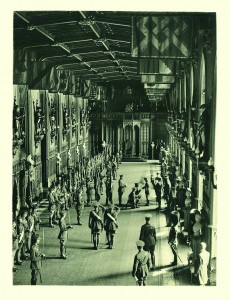
On 12 June 1922 the regimental colours of the six Southern Irish regiments were handed over to George V at Windsor Castle. Cuffe was a guest and the lunch menu.
By early 1918 it was suspected that the Germans feared internal unrest and wanted peace on economic and financial grounds. During the winter, the Germans had been expected to withdraw eight divisions from the Russian front, but owing to snow there was every reason to believe that any offensive on the Western Front would be put off until the spring. Cuffe believed that an offensive would take place in March 1918 in Champagne or elsewhere. On 19 April 1918 he reported that the Germans had 39 fresh divisions under the command of von Below of the fourteenth army and von der Marwitz of the second army, so a formidable attack could be expected on two fronts. In preparation for this, the Belgians should be responsible for the destruction of bridges and the Royal Navy for guarding the coast between Andinkerke and Dunkerque. Two battalions of Royal Marines (including two cyclist companies) ought to be able to prevent any attempted landing on the beaches. Buses could be provided at Dunkirk to move troops rapidly to any threatened point.
Whether or not Cuffe’s suggestions were carried out is unknown but the British army withstood this offensive. Cuffe suggested that home conditions for the Germans must be much worse than was generally supposed, otherwise it would have paid them to wait until May before attacking, and that a calm survey of the present situation should inspire the Allies with confidence and the British nation ‘with pride in the great deeds accomplished by Sir Douglas Haig and his splendid army’. (Cuffe did not like or admire Haig, so this must have been inserted for official consumption.) Hindenburg made certain that the whole of the offensive would fall on the British army. Cuffe said that Hindenburg did not realise the strength of the Entente and the loyalty of the French. With the Allies’ improved railway system, with a larger supply of men and assisted by the Belgians and Americans, the reconquest of Belgium should be a certainty in the near future. On 25 May 1918 Cuffe reported that it was possible that the enemy would make an attack on the Calonne–Lens and Scarpe– Dernancourt fronts. South of the Somme, work on communications and dumps continued, but there had been no indication of an immediate offensive.
Cuffe’s reports end here. The Kaiser abdicated on 9 November 1918 and an armistice was declared two days later, on 11 November 1918.
With Marshal Foch
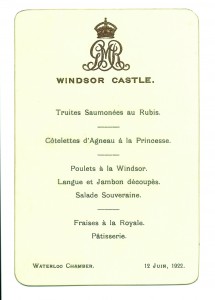 Cuffe ended the war on Marshal Foch’s staff. It is said that he flew back to England in November 1918 with the armistice papers but it has not been possible to verify this. Cuffe was mentioned in dispatches many times. He was given the Belgian Légion d’Honneur, and he was awarded the Croix de Chevalier of the Legion of Honour of France for gallantry during operations between 21 and 30 August 1914. He received the Distinguished Service Order and was made a Commander of St Michael and St George. He served as Foch’s interpreter on the Allied Military Committee of Versailles, 1922–3, which met in the Hall of Mirrors. He described the glittering scene to his children—the chan-deliers reflecting in the mirrors, the generals and other service personnel in their uniforms, their medals glinting in the lights.
Cuffe ended the war on Marshal Foch’s staff. It is said that he flew back to England in November 1918 with the armistice papers but it has not been possible to verify this. Cuffe was mentioned in dispatches many times. He was given the Belgian Légion d’Honneur, and he was awarded the Croix de Chevalier of the Legion of Honour of France for gallantry during operations between 21 and 30 August 1914. He received the Distinguished Service Order and was made a Commander of St Michael and St George. He served as Foch’s interpreter on the Allied Military Committee of Versailles, 1922–3, which met in the Hall of Mirrors. He described the glittering scene to his children—the chan-deliers reflecting in the mirrors, the generals and other service personnel in their uniforms, their medals glinting in the lights.
In 1922 the six Southern Irish regiments were disbanded. On 12 June the regimental colours of these regiments were handed over to George V at Windsor Castle. A detachment from each regiment took part in the ceremonial. Cuffe was one of those invited to have lunch with the king, queen and other members of the royal family. After the ceremony Cuffe wrote a hurried note to his wife: ‘The show was very fine, a splendid lunch, Queen Mary smoked a cigarette and Princess Mary looked very sweet’.
Cuffe retired in 1926, but by then resident magistrates were no longer wanted in Ireland. He had always intended to retire to Ireland, but when the time came he bought a house in England and only returned to Ireland to visit his mother—and, after her death, for funerals, which he always thoroughly enjoyed. He died on 27 May 1957, aged 80.
The late Patricia Silver was a daughter of J.A.F. Cuffe.
Read More: Cuffe’s background
de Rothschild’s coat
















